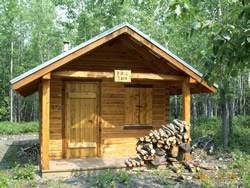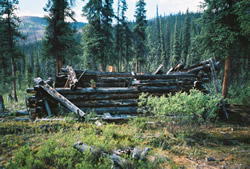
National Fire Plan Success Story
Cabin Database Success in Alaska Parks
Eastern Area Fire Management, Alaska
National Fire Plan - Fuels Reduction, Accountability
2009

Public Use Cabin in Wrangell-St. Elias National Park and Preserve that receives protection from wildland fire. NPS photo.

Cabin ruins in Yukon-Charley Rivers National Preserve that do not receive protection from wildland fire. NPS photo.
Beginning in the early 1980s, the Alaska Fire Management Program began documenting structures in Alaska national parks in order to prioritize them for protection from wildland fire. Structures were assigned a fire protection designation, critical, full, non-sensitive, or not designated, and the designation was dependent on the structure’s integrity, significance, and ownership. Critical and full sites existed on federally owned land and had historical and/or administrative significance and retained structural integrity. These sites will receive hazard fuel treatments on a recurring basis and if wildland fire threatens, sprinkler kits will be installed. Non-sensitive sites were federally owned structures that would not be protected from wildland fire. Sites with no designation occurred within the parks’ boundaries but on land not owned by the NPS (e.g. private in holdings and native corporation land) thus the NPS is not responsible for assigning fire protection standards to them.
Eastern Area Fire Management (Yukon-Charley Rivers Preserve, Gates of the Arctic National Park and Preserve, and Wrangell-St. Elias National Park and Preserve) created a database to catalog the approximately 700 structures scattered across 24 million acres. This database allows the Program to store vital information including but not limited to location data, fire protection designation, aerial and ground photographs, land ownership status, apparatus and personnel needed to equip the site with a sprinkler kit, and significance of the structure.
The creation and maintenance of this database requires cooperation between a number of programs within the NPS including archeology, ranger services, interpretation, and a variety of other areas. In addition, Eastern Area Fire Management works closely with its primary suppression agencies of BLM, Alaska Fire Service and State of Alaska, Division of Forestry, when wildland fire threatens structures within NPS boundaries.
Eastern Area Fire Management is proud to say that after over 20 years of hard work, all 700 structures have been identified, designated, and catalogued in the database. Now, “this database allows the Eastern Area Fire Management Program to be proactive with structure protection as opposed to reactive when wildland fire threatens structures,” said Mark Musitano, Eastern Area Fire Management Officer.
Contact: Andrew Ruth, Forestry Technician, (907) 455-0654.